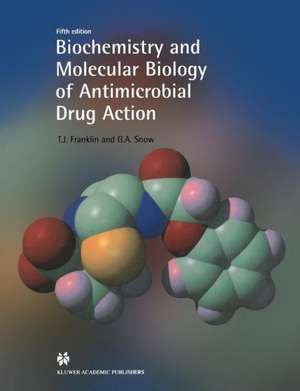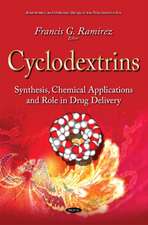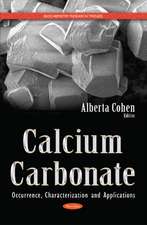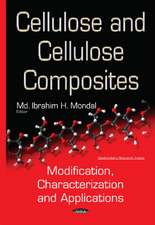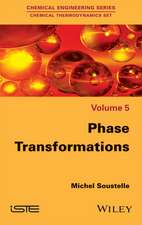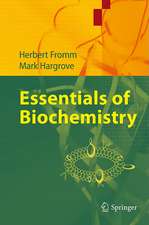Biochemistry and Molecular Biology of Antimicrobial Drug Action
Autor T. Franklinen Limba Engleză Paperback – 29 mar 2000
Preț: 637.28 lei
Preț vechi: 749.73 lei
-15% Nou
Puncte Express: 956
Preț estimativ în valută:
121.96€ • 125.99$ • 101.50£
121.96€ • 125.99$ • 101.50£
Carte tipărită la comandă
Livrare economică 26 martie-09 aprilie
Preluare comenzi: 021 569.72.76
Specificații
ISBN-13: 9780412821905
ISBN-10: 0412821907
Pagini: 166
Ilustrații: X, 166 p. 18 illus.
Dimensiuni: 189 x 246 x 10 mm
Greutate: 0.33 kg
Ediția:1998
Editura: SPRINGER NETHERLANDS
Colecția Springer
Locul publicării:Dordrecht, Netherlands
ISBN-10: 0412821907
Pagini: 166
Ilustrații: X, 166 p. 18 illus.
Dimensiuni: 189 x 246 x 10 mm
Greutate: 0.33 kg
Ediția:1998
Editura: SPRINGER NETHERLANDS
Colecția Springer
Locul publicării:Dordrecht, Netherlands
Public țintă
ResearchCuprins
1 The Development of Antimicrobial Agents Past, Present and Future.- 1.1 The social and economic importance of antimicrobial agents.- 1.2 An outline of the historical development of antimicrobial agents.- 1.3 Reasons for studying the biochemistry and molecular biology of antimicrobial compounds.- 1.4 Uncovering the molecular basis of antimicrobial action.- 1.5 Scope and layout of the present book.- 2 Vulnerable Shields — The Cell Walls of Bacteria and Fungi.- 2.1 Functions of the cell wall.- 2.2 Structure of the bacterial wall.- 2.3 Structure and biosynthesis of peptidoglycan.- 2.4 Antibiotics that inhibit peptidoglycan biosynthesis.- 2.5 Drugs that interfere with the biosynthesis of the cell wall of mycobacteria.- 2.6 The structure of the fungal cell wall.- 2.7 Inhibitors of the biosynthesis of the fungal cell wall.- 3 Antiseptics, Antibiotics and the Cell Membrane.- 3.1 Microbe killers: antiseptics and disinfectants.- 3.2 Polypeptide antibiotics.- 3.3 lonophoric antibiotics.- 3.4 Antifungal agents that interfere with the function and biosynthesis of membrane sterols.- 4 Inhibitors of Nucleic Acid Synthesis.- 4.1 Compounds affecting the biosynthesis and utilization of nucleotide precursors.- 4.2 Inhibitors of nucleic acid biosynthesis at the polymerization stage.- 5 Inhibitors of Protein Biosynthesis.- 5.1 Ribosomes.- 5.2 Stages in protein biosynthesis.- 5.3 Puromycin.- 5.4 Inhibitors of aminoacyl-tRNA formation.- 5.5 Inhibitors of initiation and translation.- 5.6 Inhibitors of peptide bond formation and translocation.- 5.7 Nitrofurantoin — a ribosomal poison?.- 5.8 Effects of inhibitors of 70S ribosomes on eukaryotic cells.- 6 Antimicrobial Drugs with other Modes of Action.- 6.1 Antibacterial agents.- 6.2 A unique antifungal antibiotic — griseofulvin.- 6.3Antiviral agents.- 6.4 Antiprotozoal agents.- 7 Penetrating the Defences: How Antimicrobial Drugs Reach Their Targets.- 7.1 Cellular permeability barriers to drug penetration.- 7.2 Multidrug efflux in bacteria.- 7.3 Examples of the uptake of antibacterial drugs.- 7.4 Uptake of antimicrobial drugs by eukaryotic pathogens.- 8 The Genetic Basis of Resistance to Antimicrobial Drugs.- 8.1 Mutations and the origins of drug-resistance genes.- 8.2 Gene mobility and transfer in bacterial drug resistance.- 8.3 Global regulators of drug resistance in Gram-negative bacteria.- 9 Biochemical Mechanisms of Resistance to Antimicrobial Drugs.- 9.1 Enzymic inactivation of drugs.- 9.2 Modification of drug targets.- 9.3 Drug efflux pumps.- 9.4 Other mechanisms of resistance.- 9.5 Drug resistance and the future of chemotherapy.
